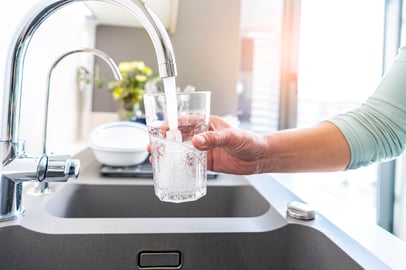 We all know it’s essential to stay hydrated in the summer and that the best way to do so is by drinking plenty of water. But is there a certain type of water, such as “alkaline” water, that offers better hydration? Here’s what our RD has to say.
We all know it’s essential to stay hydrated in the summer and that the best way to do so is by drinking plenty of water. But is there a certain type of water, such as “alkaline” water, that offers better hydration? Here’s what our RD has to say.
Alkaline water is typically fortified with small amounts of “alkalizing” minerals such as calcium, magnesium, potassium, and/or sodium to increase its pH, making it less acidic. The pH scale is used to specify the acidity or basicity (alkalinity) of a water-based solution. The pH scale ranges from 0, highly acidic, to 14, highly basic. For perspective, some everyday liquids and their respective pHs include battery acid (pH = 0), tomato juice (pH = 4), baking soda (pH = 9) and bleach (pH = 13). While pure water has a pH of 7, alkaline water typically has a pH of 8 or 9.
Some individuals hypothesize that drinking water with a higher pH than that of the body’s blood - between 7.35 and 7.45 for healthy individuals - can help decrease acidity in the body by raising its overall pH. However, the pH of the body is tightly regulated by our kidneys and lungs and excessive acid build up is unlikely, unless an underlying health condition is present, such as kidney or respiratory failure, severe infection, uncontrolled diabetes, or physical muscle trauma. Even in cases such as these, a lot more would need to be done than drinking water with a slightly higher pH than that of the body. With a pH of closer to 2-3, stomach acid would likely neutralize the water immediately, regardless of how high its pH. And even if the extra “alkaline” in alkaline water was able to make it into our bloodstream, it would quickly be filtered by our kidneys and removed from the body by way of our urine.
Overall, alkaline water is still water; therefore, it is generally safe for consumption and serves its main purpose: to hydrate you. However, any out of the ordinary health benefits boasted on the label are likely just a marketing tactic. Nevertheless, alkaline water is a great choice for hydration, especially when compared to sugary, high-calorie beverages such as soda, sugary sports drinks, and/or juice. Be sure to stay hydrated this summer by drinking plenty of water - alkaline or not!


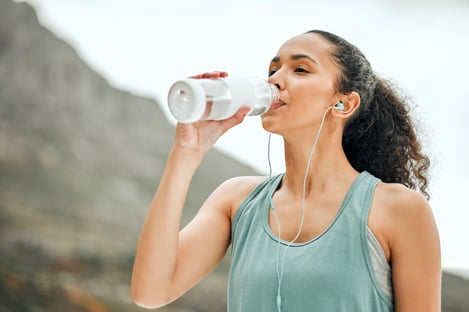 Do you drink enough water throughout the day? The body and all of the systems in it require a certain level of water to preform everyday activities. Staying hydrated can help move waste out, maintain a normal body temperature, and cushion your joints. Here are six tips to make sure you stay hydrated throughout the day.
Do you drink enough water throughout the day? The body and all of the systems in it require a certain level of water to preform everyday activities. Staying hydrated can help move waste out, maintain a normal body temperature, and cushion your joints. Here are six tips to make sure you stay hydrated throughout the day.  Throughout my career in the health and fitness industry, I am constantly asked “what’s the best” cardio equipment, snacks, health bars, time of day to exercise, etc. Hopefully I can shed some light on some simple but important questions and answers.
Throughout my career in the health and fitness industry, I am constantly asked “what’s the best” cardio equipment, snacks, health bars, time of day to exercise, etc. Hopefully I can shed some light on some simple but important questions and answers.  Wash your hands.
Wash your hands.
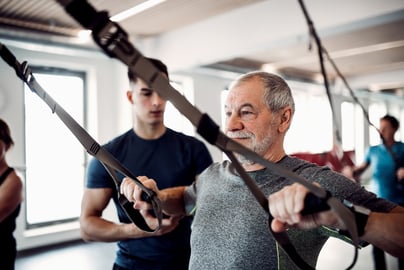 Working with a senior population, the most commonly asked question I probably get is “How can I strengthen my legs/back/core.. etc?” As exercise professionals, we already know how as far as the exercise prescription goes, but with seniors, modality often becomes a challenge. Our clients typically have a whole range of physical issues to deal with including joint pain, balance issues, and overall weakness so the traditional sit-to-stand exercises aren’t always applicable. That’s where the TRX suspension training system comes into play.
Working with a senior population, the most commonly asked question I probably get is “How can I strengthen my legs/back/core.. etc?” As exercise professionals, we already know how as far as the exercise prescription goes, but with seniors, modality often becomes a challenge. Our clients typically have a whole range of physical issues to deal with including joint pain, balance issues, and overall weakness so the traditional sit-to-stand exercises aren’t always applicable. That’s where the TRX suspension training system comes into play. 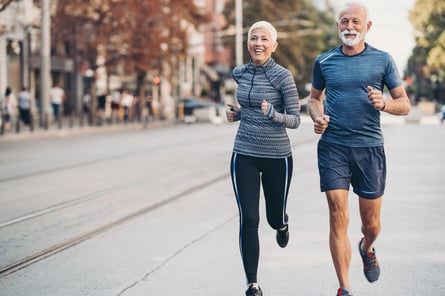 We all know that exercise is great for your health, but too often we think of improving our health as being able to move better, losing weight, having more energy, decreasing stress, or even improving our heart health, which are all great benefits don’t get me wrong! However, did you know that exercise can improve our memory and cognitive function as well? If not, you aren’t alone. The benefits that exercise can give our brain often tend to be overlooked.
We all know that exercise is great for your health, but too often we think of improving our health as being able to move better, losing weight, having more energy, decreasing stress, or even improving our heart health, which are all great benefits don’t get me wrong! However, did you know that exercise can improve our memory and cognitive function as well? If not, you aren’t alone. The benefits that exercise can give our brain often tend to be overlooked.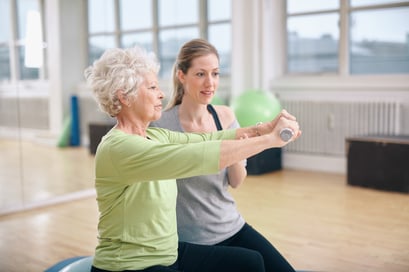 Working on one’s strength, agility, form, balance and flexibility are all so very important. Building/working on one’s strength helps prevent or lessen an injury. Using weights helps to strengthen the muscles. That being said, working the same muscles every day is not beneficial. Muscles need time to recover. Doing repetitive movements breaks the muscles down and causes wear and tear which leads to injury.
Working on one’s strength, agility, form, balance and flexibility are all so very important. Building/working on one’s strength helps prevent or lessen an injury. Using weights helps to strengthen the muscles. That being said, working the same muscles every day is not beneficial. Muscles need time to recover. Doing repetitive movements breaks the muscles down and causes wear and tear which leads to injury.  As we age there are many different changes that start to happen to our brain such as shrinkage, vasculature and cognition. With age, the brain shrinks and changes occur at all levels, from chemicals to morphology. Stroke, lesions, and dementia are all more common as people get older, as is memory impairment. Fortunately there are quite a few things we can do to help prevent or slow the process of some of those changes from happening. Regular exercise, a good diet, and low to moderate alcohol consumption, all of which minimize cardiovascular risk, appear to help the aging brain, as does increasing cognitive exertion in the form of schooling, games or meaningful activities. Physical and mental health may be the best defense against the effects of aging on the brain.
As we age there are many different changes that start to happen to our brain such as shrinkage, vasculature and cognition. With age, the brain shrinks and changes occur at all levels, from chemicals to morphology. Stroke, lesions, and dementia are all more common as people get older, as is memory impairment. Fortunately there are quite a few things we can do to help prevent or slow the process of some of those changes from happening. Regular exercise, a good diet, and low to moderate alcohol consumption, all of which minimize cardiovascular risk, appear to help the aging brain, as does increasing cognitive exertion in the form of schooling, games or meaningful activities. Physical and mental health may be the best defense against the effects of aging on the brain.
 Did you know federal law doesn’t require the potency, purity, efficacy, or safety of dietary supplements to be proven prior to being put on the market? In fact, most dietary supplements are already being sold before the Food and Drug Administration’s safety monitoring role begins. This means you could be taking a supplement that doesn’t even contain what is listed on the label, or that contains significantly different amounts than it claims to contain. This is concerning, as data from the National Health and Nutrition Examination Survey conducted in 2017-2018 revealed that close to 60% of U.S. adults reported taking a dietary supplement within the last 30 days, and this percentage is predicted to be on the rise.
Did you know federal law doesn’t require the potency, purity, efficacy, or safety of dietary supplements to be proven prior to being put on the market? In fact, most dietary supplements are already being sold before the Food and Drug Administration’s safety monitoring role begins. This means you could be taking a supplement that doesn’t even contain what is listed on the label, or that contains significantly different amounts than it claims to contain. This is concerning, as data from the National Health and Nutrition Examination Survey conducted in 2017-2018 revealed that close to 60% of U.S. adults reported taking a dietary supplement within the last 30 days, and this percentage is predicted to be on the rise.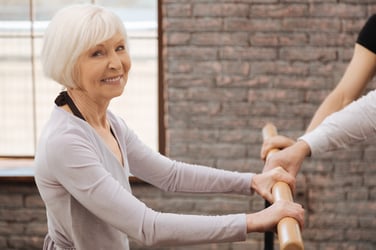 Barre, a fitness regimen, has recently gained a lot of popularity over the years. This low-impact exercise does not require any fancy, expensive equipment and people of all ages can do it. It is a workout that combines elements of Ballet, Pilates, and Yoga. It focuses on low-impact, high repetition, and small isometric movements to strengthen and tone your body.
Barre, a fitness regimen, has recently gained a lot of popularity over the years. This low-impact exercise does not require any fancy, expensive equipment and people of all ages can do it. It is a workout that combines elements of Ballet, Pilates, and Yoga. It focuses on low-impact, high repetition, and small isometric movements to strengthen and tone your body.